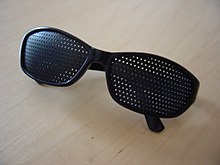Pinhole glasses

Pinhole glasses, also known as stenopeic glasses, are
Unlike conventional prescription glasses, pinhole glasses produce an image without the
Merchants state that, after prolonged use, the plastic grating should become easy to ignore. However, each time the user blinks, the horizontal lines of the grating will briefly appear to be thicker. This is because the eyelid moving over the pupil will reduce the amount of light falling onto the retina and thus will briefly remove the lateral inhibition effect which normally makes all the holes appear bigger (and the grating appear thinner). So, as long as the user keeps blinking, they will be constantly reminded of the dark grating covering their eyes.[citation needed]
Pinhole glasses have been marketed by various companies on the claim that—combined with certain
The pinhole occluder, a device used by ophthalmologists and optometrists for diagnosis of refractive errors, works on the same principles, but is not intended for use outside of diagnosis.
See also
References
- PMID 8436795
- ^ Russell S. Worrall OD; Jacob Nevyas; Stephen Barrett MD (September 12, 2007). "Eye-Related Quackery". Quackwatch. Retrieved 2008-03-27.
- ^ Cherrill Hicks (July 29, 1997). "The truth about pinhole glasses". The Independent. London. Retrieved 2020-05-31.
- ^ "Marketers of "Pinhole" Eyeglasses Settle FTC Charges That They Made False and Unsubstantiated Claims That the Glasses Could Correct or Cure Vision Disorders |". Federal Trade Commission Press Release. 1993-10-21. Retrieved 2020-05-31 – via Quackwatch.
External links
 Media related to Pinhole glasses at Wikimedia Commons
Media related to Pinhole glasses at Wikimedia Commons



